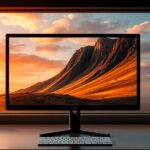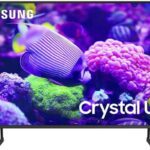In today’s tech-savvy world, choosing the right monitor can feel like a daunting task—especially when you’re trying to decide between a setup for a Mac or a Windows PC. With distinct advantages and drawbacks to each platform, understanding how monitors perform with each operating system is crucial. So, let’s dive into the nitty-gritty details of “Monitors for Mac vs Windows PCs” and discover which setup might be best for you.
Best Monitors for Mac Users Compared to Windows PCs
When it comes to selecting the best monitors, both Mac users and Windows PC enthusiasts have their preferences. Mac users often gravitate towards displays that complement the sleek design aesthetics of Apple products. Think about the Apple Pro Display XDR—a top-tier choice for creatives who require unparalleled color accuracy and HDR performance. It’s like the Mona Lisa of monitors—expensive but absolutely stunning!
On the flip side, Windows users can explore a broad range of options, from budget-friendly displays to high-end gaming monitors. Models like the Dell UltraSharp U2720Q provide excellent color reproduction and versatility, making it a favorite for professionals across various fields. And let’s not forget options like the ASUS ROG Swift—a gaming monitor that can give you a competitive edge with its high refresh rates.
Ultimately, the best monitor boils down to your specific needs. Are you a graphic designer who needs precise colors? Or perhaps a gamer who values speed? The options are vast, with dedicated choices available for both Mac and Windows users.
Differences in Monitor Compatibility for Mac and Windows Systems
You know how it is—compatibility issues can be a real drag. When it comes to monitors, Macs and Windows PCs can have different levels of compatibility with various display technologies. For instance, Macs are generally known for their seamless integration with Thunderbolt 3 and USB-C displays. If you plug in a monitor with these ports, it often just works—no fuss, no muss.
Windows PCs, however, are a mixed bag. While many monitors are compatible, some require additional drivers or settings adjustments. Plus, it’s not uncommon to encounter issues with resolution scaling or refresh rates on Windows, especially with ultra-wide monitors or those boasting high pixel densities.
This is not to say that either system is inherently better; rather, each has its quirks. Be sure to check compatibility before making a purchase. After all, nothing is worse than getting a shiny new monitor that refuses to play nice with your setup.
Choosing the Right Monitor for Creative Work on Mac vs Windows
When it comes to creative work, the stakes are high. Color accuracy, resolution, and overall display quality can heavily influence your workflow. For Mac users, monitors like the LG UltraFine 5K have gained a reputation for their vibrant colors and high pixel density—ideal for photo and video editing. It’s like having a miniature cinema right on your desk!
Windows users, however, have a plethora of options. Monitors such as the BenQ PD3220U are designed specifically for designers and creative professionals, offering excellent color reproduction and a range of connectivity options. The advantage of Windows is that you can often find monitors with similar specs at various price points, allowing for greater flexibility based on your budget.
So here’s the deal: If you’re an artist or designer, prioritize monitors with high color accuracy (look for at least 99% sRGB coverage) and resolution (4K is often the sweet spot).
Performance of High-Refresh-Rate Monitors on Mac vs Windows PCs
Gaming? Oh, we’re getting into the fun part! High-refresh-rate monitors can dramatically enhance your gaming experience, but their performance can vary significantly between Mac and Windows systems.
Windows PCs thrive with high-refresh-rate monitors, especially when paired with powerful graphics cards. If you’re a gamer, you’ll want something that supports 144Hz or even 240Hz refresh rates for that buttery smooth gameplay—just think of it as upgrading from a tricycle to a sports car!
Macs, on the other hand, have traditionally lagged behind when it comes to gaming performance. While newer Macs can handle some gaming (thanks to advancements in Apple Silicon), they’re still not the first choice for hardcore gamers seeking high refresh rates. Some high-refresh-rate monitors may work with Macs, but you might not experience the same performance benefits as on Windows.
So, if gaming is your primary focus, Windows is where it’s at! But if you’re using your Mac for a mix of work and casual gaming, you’ll still find some decent options.
User Experience with Monitors on Mac vs Windows Operating Systems
At the end of the day, user experience is paramount. And, oh boy, do Macs and Windows PCs provide different experiences!
Mac users typically enjoy a more streamlined experience when connecting monitors. The macOS handles scaling well, and if you use an Apple display, you can expect consistent color profiles and brightness levels. Plus, macOS is designed to work flawlessly with Retina displays, where text and images pop out beautifully.
Windows users, however, might have to get their hands a bit dirty. While Windows 10 and 11 have made significant strides in terms of display scaling and multiple monitor support, issues can still arise. For example, some monitors may not automatically adjust to the correct resolution or refresh rate, leading to a frustrating experience. But hey, we all love a good challenge, right?
One common issue that both Mac and Windows users face is with multi-monitor setups. It can be a bit of a balancing act when trying to manage different resolutions and orientations. But you know what they say—practice makes perfect!
Conclusion: Which Monitor is Right for You?
Ultimately, the choice between monitors for Mac and Windows PCs boils down to your specific needs and preferences. If you’re a Mac user focused on creative work, you might lean towards high-resolution displays with exceptional color accuracy. On the other hand, Windows PCs offer a vast array of options that cater to various needs—be it gaming, design, or general productivity.
While both platforms have their advantages and quirks, the key takeaway is this: Do your research, evaluate your primary use case, and consider the compatibility of your chosen monitor with your system. Because at the end of the day, nothing beats the satisfaction of having a monitor that complements your workflow, whether you’re editing photos, playing games, or just binge-watching The Office for the hundredth time.
So, what’s it gonna be? A sleek Mac setup or a powerful Windows rig? The choice is yours—and may your monitor shopping be ever in your favor!




